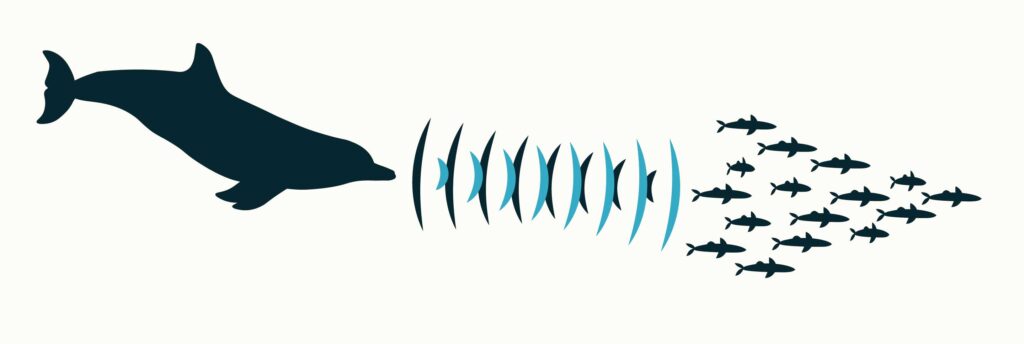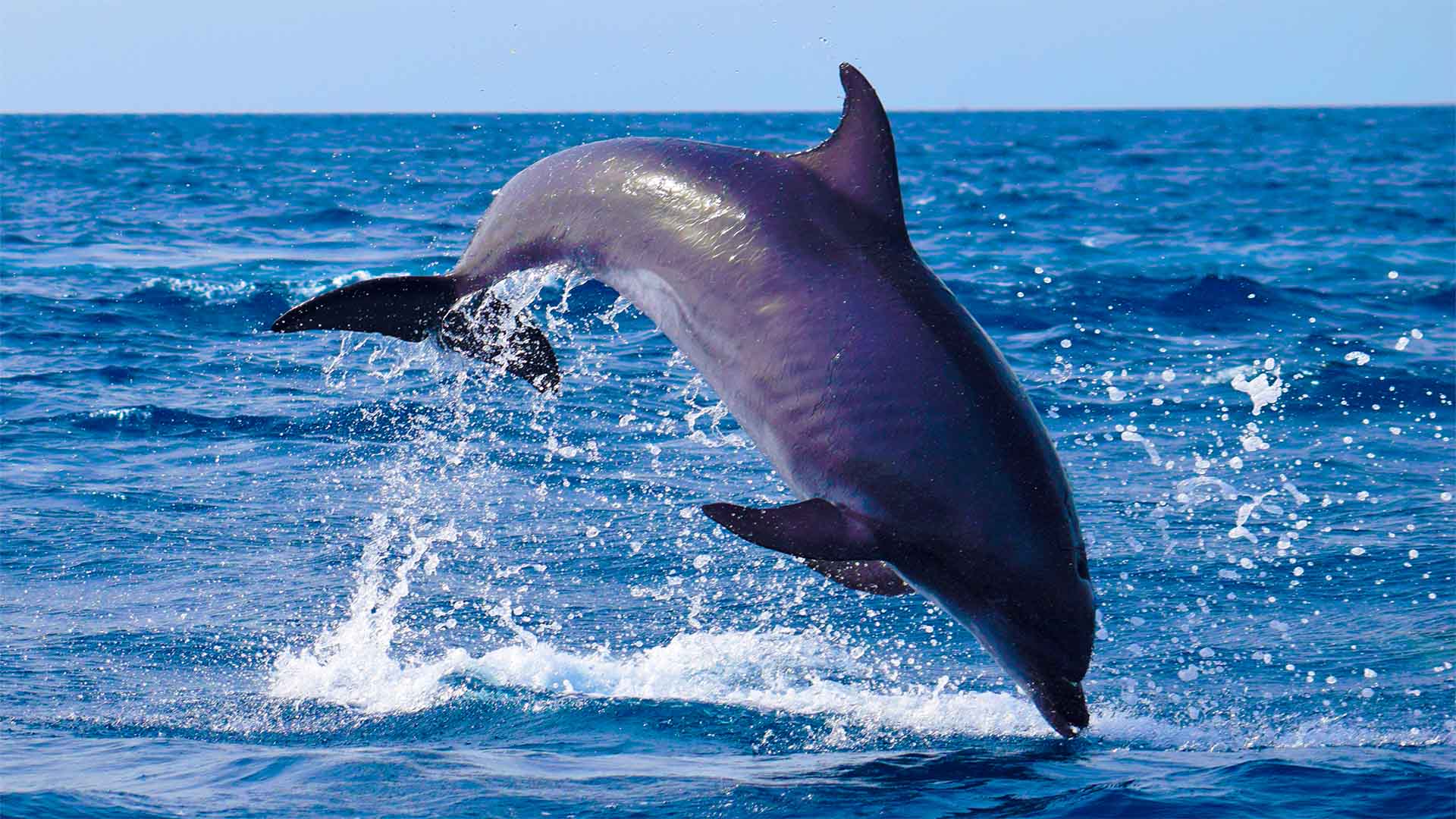In order to answer the question, “How smart are dolphins?,” we delve deeper into the subject of dolphin intelligence, including topics like brain size and behavior.
Dolphins outperform all other extremely intellectual members of the ape family in terms of brain-to-body ratio, coming in second only to humans. A bottlenose dolphin’s brain normally weighs 1,500 to 1,700 grams, which is four times larger than a chimpanzee’s brain and somewhat more than a human’s. Although brain size alone does not predict intelligence, scientists say having a large brain in comparison to one’s physique can undoubtedly assist free up space for more difficult cognitive activities.
High-level brain processes, including thinking, knowing, remembering, judging, and problem-solving, are together referred to as cognition. We can employ language, creativity, perception, and planning thanks to these cognitive processes.
Problem-Solving
Tanner, a bottlenose dolphin, used his problem-solving skills to mimic the behaviors of other dolphins and humans while being blindfolded in an experiment carried out in 2010 at the Dolphin Research Center on Grassy Key, Florida. Tanner used his hearing to detect the proximity and position of other dolphins and his trainer while his eyes were shielded by latex suction cups (in a follow-up study). Tanner was able to imitate his trainer’s shifting swimming patterns despite being unable to see him, despite the fact that the sound of a person in the water is different from the sound of another dolphin in the water.
Future Planning – Dolphin’s Intelligence As A Human
Kelly, who lived at the Institute for Marine Mammal Studies in Mississippi and had a reputation for baiting gulls in the early 2000s. Her cunning antics began when the personnel started giving the dolphins fish as a reward for picking up trash. Knowing that she would get more goodies with more pieces of paper, Kelly made a decision to bury a piece of paper behind a rock at the bottom of the pool so she could tear off a tiny piece at a time.
Kelly started placing fish where she had previously hidden pieces of paper and luring gulls with her own delicacies until she realized that a seagull would bring her even more fish than a piece of paper. This instance of the trainer learning from the trainee demonstrated that Kelly was indeed capable of making future plans and comprehending the idea of postponing gratification.
Communication

Dolphins have a sophisticated and intricate communication system that enables them to identify precisely which member of the pod is “talking” to them. Although captive animals have been taught to react to certain hand gestures, their preferred means of communication are pulses, clicks, and whistles rather than vision.
They also develop their language in a manner that is quite similar to that of humans, beginning as babblers and gradually picking up the rules of language. And, of course, the numerous dolphins trained in captivity to perform tricks demonstrate that they can also pick up on human vocabulary and syntax.
Echolocation

Dolphins utilize echolocation, also known as bio sonar, a physiological technique used by toothed whales, bats, shrews, and some birds. This enables some creatures to use sound waves—which travel four and a half times quicker in water than on land—to identify far-off, occasionally invisible items. Most animals, including whales, produce these sounds with their larynxes, but dolphins drive air down their nasal passages to produce “click trains,” which are a series of brief, broad-spectrum pulses.
Tanner was unable to use sight, but he was able to locate his trainer via echolocation and imitate his motions precisely. Dolphins utilize echolocation to locate food sources and perhaps dangerous aquatic objects.
Self-Recognition – Dolphin’s Amazing Intelligence
The fact that dolphins can recognize themselves in a mirror is one of the most obvious proof of their intelligence. A method used to gauge self-awareness is the mirror test, often known as the mark test or MSR, for “mirror self recognition.” So far, only dolphins, big apes, orcas, one elephant, the Eurasian magpie, and cleaner wrasse have succeeded in passing the exam.

The mirror test often entails anesthetizing an animal, marking a region of its body that it can’t ordinarily see, and then placing it in front of a mirror when it wakes up to see if it looks at the mark. If it does, the reflective surface provides proof that it is capable of self-recognition. This technique was used to test two male bottlenose dolphins in 2001, and the results showed that not only did the dolphins recognize themselves, but they also offered a “striking illustration of evolutionary convergence with great apes and humans.”
Such exploratory actions as “repetitive head circling” and “near observation of the eye or genital region reflected in the mirror” were mentioned in the study. Recent studies have shown that dolphins are able to recognize themselves in a mirror around seven months sooner than humans are, at the age of 15 to 18.
Memory
Another measure of cognitive ability is long-term memory, and a 2013 study found that dolphins have the longest memory of any animal save humans.
Forty-three bottlenose dolphins who were a part of a long-running breeding partnership between the United States and Bermuda participated in the study, which was directed by University of Chicago animal behaviorist Jason Bruck. First, until the dolphins got tired of them, the researchers broadcast unfamiliar dolphin whistles over a speaker. The dolphins perked up when they started playing the whistles of former social partners they hadn’t seen in 20 years; some of them whistled their own “names” and waited for a reaction.
Dolphins Use Tools – Dolphin’s Incredible Intelligence

Dolphins utilize tools, which was formerly assumed to be a capability exclusive to humans, just like monkeys, crows, and sea otters do. A population of Indo-Pacific bottlenose dolphins that had been the focus of the extensive investigation was spotted multiple times in the 1990s dragging sponges through deep water passages. The phenomenon predominantly affected women.
Researchers came to the conclusion that the sponges were most likely being used as a foraging tool, perhaps to protect their snouts from sharp things, stinging sea urchins, and the like. The study highlighted that they might be playing with the sponges or using them for medical purposes.
It can be seen that the dolphin’s brain is extremely developed and more special than other sea creatures. Therefore, dolphins became the smartest species in the world.
Read more Gay dolphins were spotted off the coast of Australia
